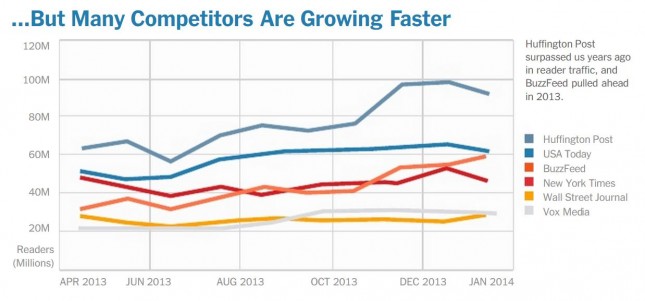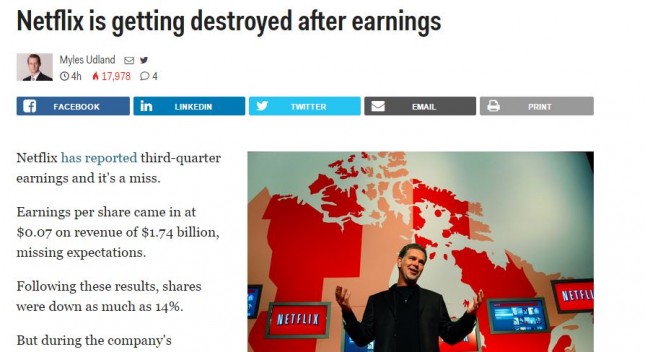This past year, The New York Times had an epic “It’s not you, it’s me” moment.
It’d be more accurate to say the bastion of traditional journalism had a “Well actually, it is you” moment. Buzzfeed and later Mashable published the news organization’s “Innovation” report, an internal Times document. It chronicles the changing face of news and identifies way its news team can push ahead of the ever-multiplying competition.

For content managers, the report served as a reminder that new media strategies can be instructive both in terms of content creation and delivery. Emerging news platforms often mirror the best qualities of content marketing in that they are highly visual, driven by content of exceptional quality and engineered to be highly shareable.
“The New York Times is winning at journalism,” the authors wrote in the “Innovation” report. “Of all the challenges facing a media company in the digital age, producing great journalism is the hardest. Our daily report is deep, broad, smart and engaging — and we’ve got a huge lead over the competition. At the same time, we are falling behind in a second critical area: the art and science of getting our journalism to readers. We have always cared about the reach and impact of our work, but we haven’t done enough to crack that code in the digital era.”
In this post, we’ll briefly examine the lessons content managers can learn from three new media organizations—Business Insider, Vice and Vox.
Business Insider publishes continuously on every topic people care about
Founded in 2007, Business Insider represents a “purely digital business model and focus on millennials” with its blend of original news coverage and eye-catching photography on every topic under the sun including politics, business (obviously), technology, fast food and entertainment.
For example, this report explains millennial buying habits to retailers with a hit-and-miss collection of business behaviors that will gain (or lose) favor among this generation. Instead of simply writing out a potentially dull interview with a wonky market researcher, Business Insider weaves relevant chunks of the interview into a snackable narrative full up with links to related coverage from—who else?—Business Insider.
Or take this more straightforward storytelling approach to Netflix’s recent Q3 earnings report. Business Insider opted for this catchy headline…

…yet this SEO-friendly URL: http://www.businessinsider.com/netflix-q3-earnings-october-14-2015-10
On social media, Business Insider is prolific, another advantage to some legacy news organizations. Its flagship Facebook stream alone contains dozens of daily posts, many of them published within minutes of one another. It highlights the spectrum of Business Insider coverage, from practical stories about falling in love for real to serious political coverage.
Compare and contrast how Business Insider and the Times used Facebook to talk about the recent Democratic Party presidential debate. The Times notes Bernie Sanders’ fans claim he won the debate, even as many observers chalked up the win to Hillary Clinton:

Meanwhile, Business Insider built an animated video contrasting news organizations’ assessments versus those of viewers:
When you look at the polls, it seems like Bernie Sanders actually beat Hillary Clinton in last night's debate.Follow INSIDER for more videos like this.
Posted by Business Insider on Wednesday, October 14, 2015
From a strictly “gee whiz there are moving parts” perspective, the Business Insider post sells the story more compellingly than the traditional photo-and-link by the Times.
New media strategies for content managers:
- There are about a dozen ways to skin any content cat, and you should try several of them to find out which resonates best with your audience.
- Visuals always, always, always win eyeballs—photos are awesome, but videos and animations are even better.
- You will get more people to read your compelling original content if you actually write conversationally about topics that matter to people, both straightforward and salacious.
Vice pairs a vast visual library with innovative investigative reporting
Vice has been around since 1994, but it has attracted a ton of positive press in recent months for its groundbreaking investigative journalism. Its bio page explains how the organization is, in fact, a media empire that includes tons of original video at Vice.com, a television production studio, a magazine, a book-publishing division and much more.
The new media organization packs its homepage full of visual elements with plenty of supporting text and lengthy headlines plus keywords that help the reader navigate content by topic, whether travel or business.
Vice uses conversational and often unfiltered language to tell stories, and it achieves this by employing real investigative journalists. Continuing the theme of Sanders vs. Clinton introduced above, here’s an excerpt from a colorful Vice Q&A with an investigative journalist articulating why people should still care about Clinton’s handling of email messages as secretary of state.

One major selling point of Vice is its emphasis on original and high-quality video. The news organization recently collaborated with HBO on a documentary highlighting why the U.S. prison system needs reform:
It then debuted the film for some of the very prisoners it interviewed and shared the event on social media such as Instagram.

New media strategies for content managers:
- The interplay of high-impact visuals and sharply written text is critically important. Focus more, not less, on packaging content whose context is immediately apparent and thus shareable.
- Edgy is a quality people admire. Be responsible and fierce in creating original content that tells the stories you think matter most.
- Partner with powerhouse distribution platforms—think legacy media such as HBO or automation technology such as Marketo—to get your incredible content to the masses.
Vox puts a Google-like spin on storytelling
The Times’ Innovation report actually calls out Vox as one of the rising stars on the new media scene, making it the perfect organization to end on as content managers explore compelling new media strategies.
Compare homepages of Vox and the Times, and you’ll find that while both are packed with links and compelling photos, Vox presents a generally cleaner and more interactive tone.
Hover over Vox headlines with your mouse and yellow highlighting appears, drawing attention to interesting headlines that blend into the color palette of the page. Big visual strips draw you into stories.
Like Business Insider, Vox makes no bones about the fact that the target audience for its eight properties is “affluent and educated young adults worldwide.” One way it achieves this goal is by taking a page out of Google’s book and writing a series of explanatory pieces, known as Explainers, which essentially anticipate questions its audience will ask on any subject du jour.
Also noteworthy is Vox’s in-story navigation, which adopts the visual cues of a timeline and deploys it to link readers to related content published in recent days.
Lastly, calls to action at Vox encourage clicks to interactive content—a critical value-add in an Internet age when anyone with access to Wi-Fi and WordPress can fashion himself a journalist.
New media strategies for content managers:
- Spend time getting to know the topics that interest your audience most. Then go out of your way to provide original content satisfying those interests in ways no one else can.
- Keep it clean. Reduce clutter surrounding content to sell its value and let the story speak for itself.
- Advance the story on multiple fronts, and tell it each time in a way that fits each platform individually.
Content managers who spend even a few minutes with these channels will find plenty of reminders and actionable new media strategies for winning over audiences. It’s about time you subscribed.
Nate Birt is a multimedia journalist, social media enthusiast and copy editor with experience at a variety of print and digital publications, and a Contributing Editor to the Visually Blog. Follow him on Twitter at @natebirt.
The post New Media Strategies That Scoop the Real Reporters appeared first on Visually Blog.
from Visually Blog
http://blog.visual.ly/new-media-strategies-scoop-real-reporters/
No comments:
Post a Comment